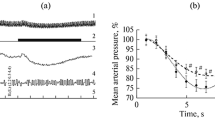Abstract
The effect of the state of sleep and wakefulness on transmission of afferent stimuli and subsequent inhibitory processes in the posterior ventral nucleus of the thalamus was studied in chronic experiments on unanesthetized cats. In a drowsy state and in a state of superificial sleep stimulus transmission is reduced, whereas in an active state (during the arousal reaction, movement, eating, etc.) it is increased. In paradoxical sleep stimulus transmission is at the same level as in a state of quiet wakefulness. In a drowsy state and in the first phase of sleep marked fluctuation of transmission is observed. The level of stimulus transmission is most stable in active states. The intensity of the after-inhibition following transmission of the afferent signal depends on the level of anesthesia, of wakefulness, and of natural sleep. Processes following transmission of the afferent stimulus in the posterior ventral nucleus of the thalamus during barbiturate anesthesia differ radically from those in the unanesthetized animal. After-inhibition, so characteristic of anesthesia, is manifested in the drowsy state only to a slight degree, and in the waking state it is not exhibited at all.
Similar content being viewed by others
Literature Cited
É. Lang and V. L. Glants, Byull. Éksp. Biol. Med., No. 1, 3 (1975).
É. Lang and R. A. Durinyan, Byull. Éksp. Biol. Med., No. 9, 1027 (1976).
P. Andersen and J. C. Eccles, Nature,196, 645 (1962).
P. Andersen and T. A. Sears, J. Physiol. (London),173, 459 (1964).
J. R. Bartlett, R. W. Doty, Y. Pecci-Saavedra, et al., Exp. Brain Res.,18, 214 (1973).
A. Courtois and J. P. Cordeau, Brain Res.,14, 199 (1969).
N. Dagnino, E. Favale, C. Loeb, et al., Arch. Ital. Biol.,107, 668 (1969).
H. H. Jasper and C. A. Ajmone-Marsan, A Stereotaxic Atlas of the Diencephalon of the Cat, Ottawa (1954).
L. J. Malcolm, I. S. Bruce, and W. Burke, Exp. Brain Res.,10, 283 (1970).
J. T. Walsh and J. P. Cordeau, Exp. Neurol.,11, 80 (1965).
Rights and permissions
About this article
Cite this article
Lang, É., Durinyan, R.A. Effect of the state of sleep and wakefulness on transmission of the afferent signal through the posterior ventral nucleus of the thalamus. Bull Exp Biol Med 83, 441–444 (1977). https://doi.org/10.1007/BF00807470
Received:
Issue Date:
DOI: https://doi.org/10.1007/BF00807470



